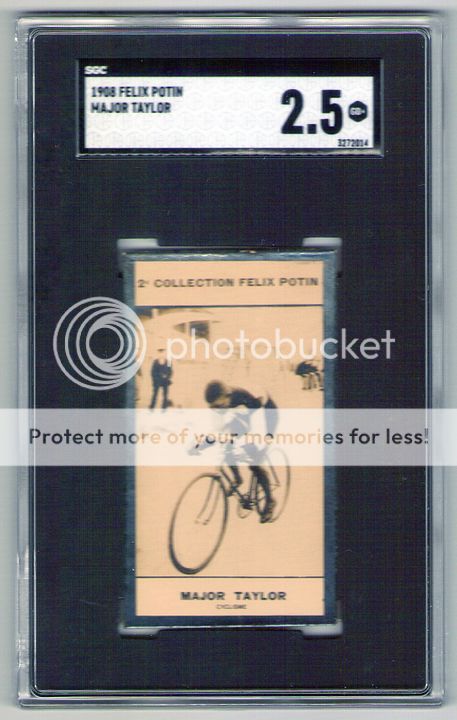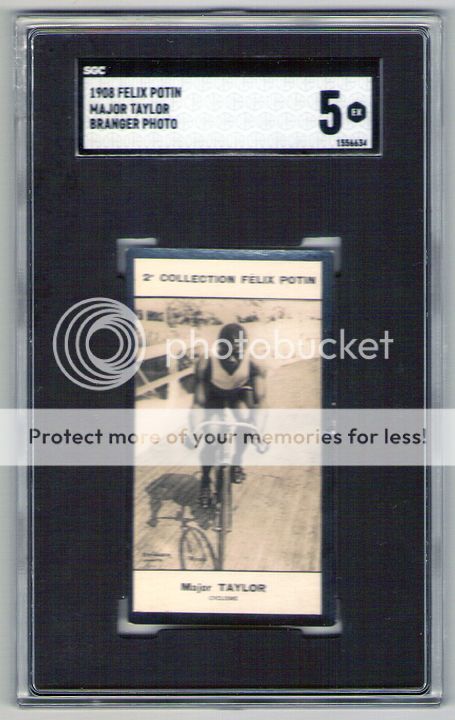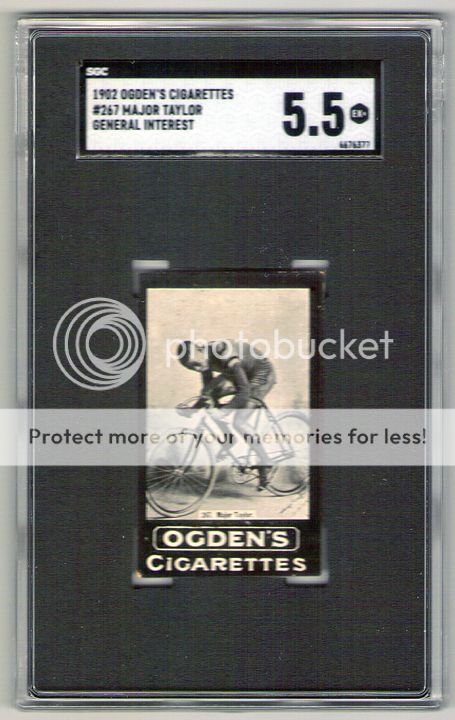|
|
#1
|
||||
|
||||
|
An amazing story: This one copied off of Wikipedia but just scratches the surface there are a few in-depth articles online that illustrate his remarkable accomplishments in the face of 19th-century adversity.
Marshall Walter "Major" Taylor (November 26, 1878 – June 21, 1932) was an American professional cyclist. He was born and raised in Indianapolis, where he worked in bicycle shops and began racing multiple distances in the track and road disciplines of cycling. As a teenager, he moved to Worcester, Massachusetts, with his trainer and had a successful amateur career, which included breaking track records. Taylor turned professional in 1896, at the age of 18, living in cities on the East Coast and participating in multiple track events including six-day races. He moved his focus to the sprint event in 1897, competing in a national racing circuit, winning many races, and gaining popularity with the public. Between 1898 and 1899, he set numerous world records in race distances ranging from the quarter-mile (0.4 km) to the two-mile (3.2 km). Taylor won the sprint event at the 1899 world track championships to become the first African American to achieve the level of cycling world champion and the second black athlete to win a world championship in any sport (following Canadian boxer George Dixon, 1892). He was also a national sprint champion in 1899 and 1900. He raced in the U.S., Europe, and Australia between 1901 and 1904, beating the world's best riders. After a 2+1⁄2-year hiatus, he made a brief return in 1907, before retiring aged 32 to his home in Worcester in 1910. Towards the end of his life Taylor faced severe financial difficulties, which forced him into poverty. He spent the final two years of his life in Chicago, Illinois, where he died of a heart attack in 1932. Throughout his career he challenged the racial prejudice he encountered on and off the track and became a pioneering role model for other athletes facing racial discrimination. ____________________________ I Am ALWAYS buying Vintage Autographs jim@stinsonsports.com |
|
#2
|
|||
|
|||
|
Quote:
|
|
#3
|
||||
|
||||
|
Thanks, Jeff, I was unaware of the book. "Major" also self-published his autobiography which he lived off of the proceeds of. Also, I should have included this below which I never knew.
He raced all events, but Taylor was first and foremost a track sprinter. For some perspective on the popularity of cycling near the turn of the 20th century, Madison Square Garden could pack the house for six-day, indoor track events. (Similar events are still called “Madisons” in the track world.) Prizes for first place could reach upwards of $5,000, which is about $135,000 in today’s dollars. Bike racing was big time, and no one was as exciting as Major Taylor. Even President Theodore Roosevelt, the man’s man of hunting and all things rugged, was a vociferous fan of Taylor. ___________________________ Always BUYING Vintage Autographs jim@stinsonsports.com |
|
#4
|
|||
|
|||
|
Here are a few Taylor cards.
  
|
|
#5
|
|||
|
|||
|
One of the greatest cyclists of all time.
He was basically shut out of racing in the US, but found more success, acceptance and fame in both Europe and Australia. At the time the top cyclists also made appearance money just for showing up to race. Major Taylor was not only a sprint champion, but set several world records in paced races run behind a bike with 2 riders or more. Here, some tracks "fixed" his races by either providing him with the worst pacing teams, or pacing teams paid to slow him down. At least once he rode some distance yelling at them to speed up, then went past them to finish and win. Which is way harder than it sounds, at 30 mph, 80% of the riders power goes to pushing through the air. If the pacing guys are doing it, a rider con go very fast. |
|
#6
|
|||
|
|||
|
Quote:
Waltham was a center of cycle racing from 1893 to just before WWI. A velodrome, was built just to the west of South Street. Most people in the area know it as Nipper Maher Park, a series of 3 little league fields and an older league field (Connie Mack league when I was growing up). To many people it is still known as 'Bike Park'. Concrete blocks that were part of the grandstands are still visible in the woods on the edge of the park. Waltham Manufacturing Company (bikes and cars) was based in Waltham. They build a very popular and fast bike (Orient and Waltham) and sold about 100,000 of them from the 1890's to 1910's. The Charles River Museum of Industry and Innovation website has some good videos and articles about cycling. https://www.charlesrivermuseum.org/the-bicycle-craze My alma mater U/Mass Boston (Go Beacons!), besides being the home of the John F. Kennedy Presidential Library, houses the largest cycling archive in the U.S.
__________________
'Integrity is what you do when no one is looking' "The man who can keep a secret may be wise, but he is not half as wise as the man with no secrets to keep” Last edited by Michael B; 05-07-2021 at 11:11 PM. |
|
#7
|
|||
|
|||
|
Quote:
Now I have to go find those cement blocks, and when things get back to normal find some excuse to see those archives at U Mass. |
|
#8
|
|||
|
|||
|
I grew up in Waltham and I played little league at those fields. My parents still live there. If you are driving down South Street you would turn onto Dartmouth Street. I do not know which way you would go, but Dartmouth St appears to dead end at the Senior little league field. It actually continues to the left and runs along the right field line of the larger field, what we knew as Connie Mack. The blocks should be in the trees along the third base line / left field. If you go there you will also be around the corner from Mount Feake Cemetery. It is the burial place of Effie Carlton who wrote "Rock a Bye Baby" and a Civil War Medal of Honor Recipient. It is across the Charles from the Waltham Watch factory.
__________________
'Integrity is what you do when no one is looking' "The man who can keep a secret may be wise, but he is not half as wise as the man with no secrets to keep” Last edited by Michael B; 05-12-2021 at 05:30 PM. |
|
#9
|
||||
|
||||
|
I'm originally from Worcester Mass. I have heard of Taylor. A bicycle shop in Worcester had a picture of Major Taylor hanging on their wall. There's a monument of Taylor outside of the Worcester library downtown.
Last edited by DHogan; 05-12-2021 at 05:55 PM. |
|
#10
|
|||
|
|||
|
I was wondering why I did not know about it as I passed by the library every day to work out at the YWCA next door, which is much nicer than the YMCA in town. The statue was erected 4 years after I moved away. The sculptor also did the Nolan Ryan and Tom Vandergriff statues at Rangers Park. The other side is a slightly small plaque showing 3 cyclists racing. The stonework on the ground below it is designed to look like a bicycle wheel. It is at the corner of Salem Street and Library Lane off of Franklin Street near Worcester City Hall.
__________________
'Integrity is what you do when no one is looking' "The man who can keep a secret may be wise, but he is not half as wise as the man with no secrets to keep” Last edited by Michael B; 05-12-2021 at 10:17 PM. |
 |
| Thread Tools | |
| Display Modes | |
|
|
 Similar Threads
Similar Threads
|
||||
| Thread | Thread Starter | Forum | Replies | Last Post |
| Help ID'ing a Nebraska athlete | edtiques | Net54baseball Sports (Primarily) Vintage Memorabilia Forum incl. Game Used | 4 | 07-17-2017 09:03 PM |
| The Art of the Athlete | Cards&More | Net54baseball Vintage (WWII & Older) Baseball Cards & New Member Introductions | 27 | 02-17-2016 04:21 PM |
| The Greatest Players No One Has Ever Heard Of | packs | Net54baseball Vintage (WWII & Older) Baseball Cards & New Member Introductions | 17 | 07-24-2015 08:02 AM |
| The greatest pitcher you've never heard of... | familytoad | Net54baseball Vintage (WWII & Older) Baseball Cards & New Member Introductions | 20 | 03-29-2011 01:05 AM |
| Greatest athlete of all-time | Archive | Net54baseball Vintage (WWII & Older) Baseball Cards & New Member Introductions | 58 | 07-28-2005 08:37 AM |